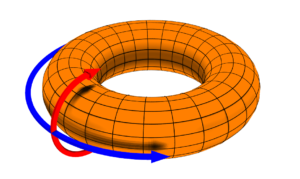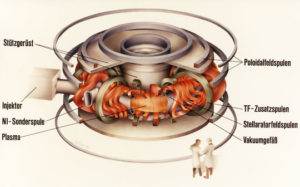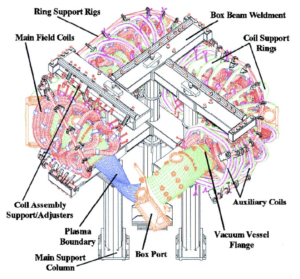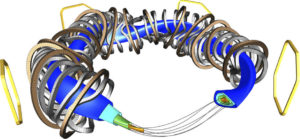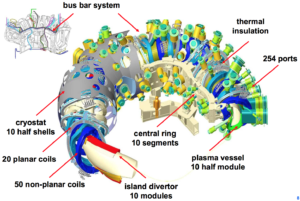Updated 19 March 2020
Peter Lobner
Background
Dr. Lyman Spitzer invented the stellarator in 1951 and built several versions of this magnetic plasma confinement machine at Princeton University during the 1950s and 1960s, establishing the world famous Princeton Plasma Physics Laboratory (PPPL) in the process. Dr. Spitzer’s earliest Stellarators were figure-eight devices as shown in the following photo.
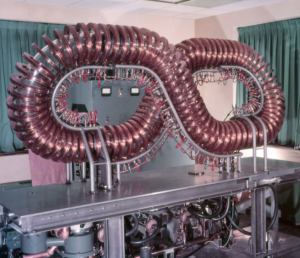 Example of an early stellarator at the 1958 Atoms for Peace Conference, Geneva
Example of an early stellarator at the 1958 Atoms for Peace Conference, Geneva
In these first-generation stellarators, field coils wrapped around the figure-eight vacuum vessel provided the basic plasma confinement field. The physical twist in the stellarator’s structure twisted the internal magnetic confinement field and cancelled the effects of plasma ion drift during each full circuit around the device. You can download Dr. Spitzer’s historic 1958 IAEA conference paper, “The Stellarator Concept,” at the following link:
The next generation of stellarators adopted a simpler torus shape and created the twist in the magnetic confinement field with helical field coils outside the vacuum vessel.
While stellarators achieved many important milestones in magnetic confinement, by the late 1960s, the attention of the fusion community was shifting toward a different type of magnetic confinement machine: the tokamak. Since then, this basic design concept has been employed in many of the world’s major fusion devices, including the Alcator-C Mod (MIT, USA), Doublet III-D (DIII-D at General Atomics, USA), Tokamak Fusion Test Reactor (TFTR at PPPL, USA), Joint European Torus (JET, UK), National Spherical Torus Experiment Upgrade (NSTX-U at PPPL, USA) and the International Thermonuclear Experimental Reactor (ITER, France).
Now, almost 50 years later, there is significant renewed interest in stellarators. The newest device, the Wendelstein 7-X stellarator, became operational in 2016. It may help determine if modern technology has succeeded in making the stellarator a more promising path to fusion power than the tokamak.
Comparison of Tokamaks and Stellarators
Modern tokamaks and stellarators both implement plasma confinement within a (more or less) toroidal vacuum vessel that operates at very high vacuum conditions, on the order of 10-7 torr. Both types of machines use the combined effects of two or more magnetic fields to create and control helical field lines (HFL) that enable plasma confinement and reduce particle drift in the circulating plasma.
In the following description, the simple “classical” tokamak configuration shown below will be the point of reference.
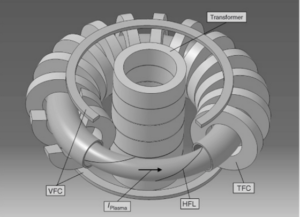 Source: Hans-Jürgen Hartfuß, Thomas Geist, “Fusion Plasma Diagnostics With mm-Waves: An Introduction”
Source: Hans-Jürgen Hartfuß, Thomas Geist, “Fusion Plasma Diagnostics With mm-Waves: An Introduction”
The main features of a tokamak are summarized below.
- The vacuum vessel in a modern tokamak typically is an azimuthally-symmetric torus of revolution (donut-shaped), typically with a vertically elongated, D-shaped cross section. Modern “spherical” tokomaks maintain the D-shaped cross section, but minimize the diameter of the hole in the center of the torus.
- Plasma confinement within the vacuum vessel is accomplished by the combined effects of a toroidal magnetic field and an induced poloidal magnetic field. Together, these fields create the helical field lines for plasma confinement. In the following diagram, the toroidal field is represented by the blue arrow and the poloidal field is represented by the red arrow.
By Dave Burke – Own work, CC BY 2.5, https://commons.wikimedia.org/w/index.php?curid=1169843
- The toroidal field (blue) is generated by a set of external toroidal field coils (TFCs) that surround the vacuum vessel.
- The poloidal field (red) is generated by a strong induced plasma current (Iplasma), on the order of 106 amperes, flowing within the plasma inside the vacuum vessel. An external coil in the center of the tokamak serves as the primary coil of a transformer and the circulating plasma serves as the secondary coil of the transformer. To create the poloidal field, the transformer primary coil is charged at a controlled rate (i.e. to yield the desired rate of flux increase), thereby inducing a current in the plasma and heating the plasma by ohmic heating. When the primary coil reaches maximum flux, current is no longer induced in the plasma and the tokamak “pulse” is over.
- A pair of vertical field coils (VFC), one above and one below the plane of the torus, provide the ability to radially position the plasma within the vacuum vessel.
- Divertors inside the vacuum vessel define the maximum extent of the magnetically confined plasma, remove impurities from the edge of the plasma, and help minimize plasma-wall interactions.
- The high current in the plasma can falter unexpectedly, resulting in a “disruption”, which is a sudden losses of plasma confinement that can unleash magnetic forces powerful enough to damage the machine.
- A tokamak is mechanically simpler than a stellarator.
- The physics characteristics of a tokamak typically yield better confinement capabilities than a stellarator.
- While the “pulse” in a modern tokamak can last several tens of minutes, a pulsed mode of operation may not be suitable for a commercial fusion reactor.
- Pulsed magnetic and thermal loads create mechanical fatigue issues that must be accommodated in the design of tokamak structures.
The simple “classical” stellarator configuration shown below will be the point of reference for the following discussion.
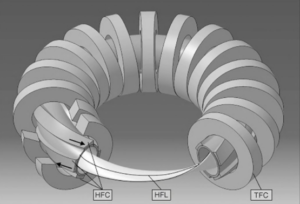 Source: Hans-Jürgen Hartfuß, Thomas Geist, “Fusion Plasma Diagnostics With mm-Waves: An Introduction”
Source: Hans-Jürgen Hartfuß, Thomas Geist, “Fusion Plasma Diagnostics With mm-Waves: An Introduction”
The main features of a stellarator are summarized below.
- There are many variants of devices called stellarators, with names such as Torsatron, Heliotron, Heliac, and Helias. All create the plasma confinement field with external magnet systems in various configurations and none depend on the existence of a toroidal plasma current.
- In the classical stellarator in the above diagram, the plasma confinement field is created by a set of planar (flat) TFCs and external pairs (1, 2 or 3) of twisting helical field coils (HFC) with opposite currents in each conductor in the pair.
- A stellarator is mechanically more complex and more difficult to manufacture than a tokamak.
- Stellarators may use a divertor or a simpler “limiter” to define the outer extent of the plasma.
- While a stellarator has no induced plasma current, other small currents, known as “pressure-driven” or “bootstrap” currents, exist. These small currents do not cause plasma disruptions as may occur in a tokamak, but complicate plasma confinement.
- A stellarator is intrinsically capable of steady-state operation.
- For a variety of reasons, a classical stellarator tends to lose energy at a higher rate than a tokamak. Advanced, modular stellarators are making progress in improving confinement performance.
You’ll find more comparative information in the July 2016 paper by Y. XU, “A general comparison between tokamak and stellarator plasmas,” which is available at the following link:
Modern stellarators
In the last two decades, dramatic improvements in computer power and 3-dimensional modeling capabilities have enabled researchers and designers to accurately model a stellarator’s complex magnetic fields, plasma behavior, and mechanical components (i.e., vacuum vessel, magnet systems and other structures). This has enabled implementation of a “plasma first” design process in which the initial design focus is on optimizing plasma equilibrium based on selected physics conditions. Key goals of this optimization process are to define plasma equilibrium conditions that reduce heat transport and particle loss from the plasma. As you might suspect, there are different technical bases for approaching the plasma optimization process. The stellarator’s magnet systems are designed to produce the confinement field needed for the specified, optimized plasma design.
This class of modern, optimized stellarators is characterized by complex, twisting plasma shapes and non-planar, modular toroidal coils that are individually designed, built and assembled. The net result is a stellarator with significantly better confinement performance that earlier stellarator designs. In this post, we’ll look in more detail at the following three advanced stellarators:
- Wendelstein 7-AS [Max Planck Institute for Plasma Physics (IPP), Garching, Germany]
- Helically Symmetric eXperiment (HSX, University of Wisconsin – Madison, USA)
- Wendelstein 7-X [Max Planck Institute for Plasma Physics (IPP), Griefswald, Germany]
Wendelstein 7-AS Stellarator (1988 – 2002)
The Wendelstein 7-AS (W7-AS) was the first modular, advanced stellarator and was the first stellarator equipped with a divertor. It was used to test and validate basic elements of stellarator optimization. Basic physical parameters of W7-AS are:
- Major radius 2 m
- Minor radius 0.2 m
- Magnetic field 2.5 – 3 T
The physical layout and scale of the W7-AS machine is shown in the first diagram, below, with more details on the magnet system in the following diagram.
Above & below: Wendelstein 7-AS. Source: Max Planck IPP, I. Weber
The W7-AS operated from 1988 to 2002. The IPP reported the following results:
- Demonstrated that the innovative modular magnet coil system can be manufactured to exacting specifications.
- Demonstrated improved plasma equilibrium and transport behavior because of the improved magnetic field structure.
- Confirmed the effectiveness of the optimization criteria.
- Demonstrated the effectiveness of a divertor on a stellarator (a common feature in tokamaks).
You’ll find more details on the W7-AS on the IPP website at the following link:
http://www.ipp.mpg.de/2665443/w7as?page=1
Its successor is the Wendelstein 7-X.
Helically Symmetric eXperiment (HSX)
HSX is a small modular coil advanced stellarator that began operation in 1999 at the Electrical and Computer Engineering Department at the University of Wisconsin-Madison. HSX basic design parameters are:
- Major radius 1.2 m
- Minor radius 0.15 m
- Magnetic field 1T
The physical arrangement of HSX is shown in the following diagram.
HSX physical configuration. Source: University of Wisconsin – Madison
The HSX was the first stellarator to be optimized to deliver a “quasi-symmetric” magnetic field. While the magnetic field strength is usually a two-dimensional function on the magnetic surfaces traced out by the field lines, quasi-symmetry is achieved by making it one-dimensional in so-called “magnetic coordinates” (Boozer coordinates).
Author Masayuki Yokoyama’s paper, “Quasi-symmetry Concepts in Helical Systems,” provides a description of quasi-symmetry.
“A key point of quasi-symmetry is that the drift trajectories of charged particles depend on the absolute value of the magnetic field (B) expressed in terms of magnetic field coordinates (Boozer coordinates). The plasma can be optimized in terms of the Boozer coordinates instead of the vector components of the field.”
You can read Yokoyama’s complete paper at the following link:
https://www.jstage.jst.go.jp/article/jspf/78/3/78_3_205/_pdf
The HSX main magnetic field is generated by a set of 48 non-planar, modular coils, arranged in four field periods, yielding the twisting flux shape shown below.
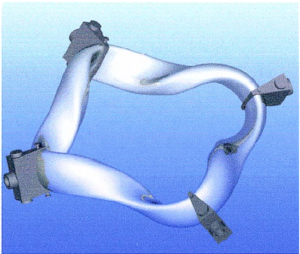
HSX plasma configuration. Source: University of Wisconsin – Madison
The HSX team reported that “this is the first demonstration that quasi-symmetry works, and you can actually measure the reduction in transport that you get.”
The home page for this project is at the following link:
You can download a description of the HSX here:
Wendelstein 7-X Stellarator
The Wendelstein 7-X (W7-X) is a Helias (helical advanced stellarator) and is the first large-scale optimized stellarator; significantly larger than Wendelstein 7-AS and HSX. The complete W7-X machine weighs about 750 tons, with about 425 tons operating under cryogenic conditions. The superconducting magnet system is designed for steady-state, high-power operation; nominally 30 minutes of plasma operation at 10 MW power. W7-X basic design parameters are:
- Major radius 5.5m
- Minor radius 0.52m
- Magnetic field 2.5 T (up to 3T)
The IPP home page for this project is here:
The W7-X is drift optimized for improved thermal and fast ion confinement by: (a) implementing quasi-symmetry to reduce transport losses, (b) minimizing plasma currents (Pfirsch-Schluter & bootstrap currents) to improve equilibrium, and (c) designing a large magnetic well in the plasma cross-section to avoid plasma pressure instabilities.
The primary purpose of the Wendelstein 7-X is to investigate the new stellarator’s suitability for extrapolation to a fusion power plant design. The IPP website provides the following clarification:
“It is expected that plasma equilibrium and confinement will be of a quality comparable to that of a tokamak of the same size. But it will avoid the disadvantages of a large current flowing in a tokamak plasma: With plasma discharges lasting up to 30 minutes, Wendelstein 7-X is to demonstrate the essential stellarator property, viz. continuous operation.”
The main assembly of Wendelstein 7-X was completed in 2014. An IPP presentation on the manufacturing and assembly of W7-X is at the following link:
https://www.iter.org/doc/www/content/com/Lists/Stories/Attachments/680/ITER_W7X.pdf
You’ll also find a good video, “Wendelstein 7-X — from concept to reality,” which provides an overview of the design and construction of the W7-X stellarator and the associated research facility, at the following link:
https://www.youtube.com/watch?v=lyqt6u5_sHA
After engineering tests, the first plasma was produced at W7-X on 10 December 2015. A November 2016 article in Nature summarized on the results of initial operation of W7-X. The article, entitled, “Confirmation of the topology of the Wendelstein 7-X magnetic field to better than 1:100,000,” confirmed that the W7-X is producing the intended confinement field. This article includes the following 3-D rendering and description of the complex magnetic coil sets that establish the twisting plasma confinement fields in the W7-X.
“Some representative nested magnetic surfaces are shown in different colors in this computer-aided design (CAD) rendering, together with a magnetic field line that lies on the green surface. The coil sets that create the magnetic surfaces are also shown, planar coils in brown, non-planar coils in grey. Some coils are left out of the rendering, allowing for a view of the nested surfaces (left) and a Poincaré section of the shown surfaces (right). Four out of the five external trim coils are shown in yellow. The fifth coil, which is not shown, would appear at the front of the rendering.”
You can read the complete article at the following link:
http://www.nature.com/articles/ncomms13493
A more detailed mechanical view of the W7-X, with a scale (gold) human figure is shown in the following diagram:
Source: IPP presentation, “Stellarators difficult to build? The construction of Wendelstein 7-X”
The large scale of the W7-X vacuum vessel is even more apparent in the following photo.
 A segment of W7-X vacuum vessel. Source: adapted from IPP by C. Bickel and A. Cuadra/Science
A segment of W7-X vacuum vessel. Source: adapted from IPP by C. Bickel and A. Cuadra/Science
Most of the wall protection components are uncooled. Operational limits on the W7-X (i.e., pulse duration, various temperatures) help protect the integrity of wall components.
The status of the W7-X as of February 2017 is outlined in a presentation by the W7-X team to the Fusion Energy Science Advisory Committee (FESAC), entitled “Recent results and near-term plans for Wendelstein 7-X,” which is available at the following link:
http://www.firefusionpower.org/FESAC_W7-X_Pedersen_02.2017.pdf
Update 19 March 2020: Proof of principal and a new upgrade campaign
In February 2020, Princeton Plasma Physics Laboratory (PPPL) reported on the SciTechDaily website that W7-X operation through the end of 2018 had successfully demonstrated the expected capability to moderate plasma leakage and improve plasma confinement. W7-X operation had achieved hundred-second pulses with heating powers of two megawatts and plasma energies of 200 megajoules. PPPL physicist Novimir Pablant stated, “This research validates predictions for how well the optimized design of the W7-X reduces neoclassical transport….,” and, “The research marks the first step in showing that high-performance stellarator designs such as W-7X are an attractive way to produce a clean and safe fusion reactor.”
You’ll find the PPPL report here: https://scitechdaily.com/cutting-edge-w7-x-nuclear-fusion-device-overcomes-obstacles/
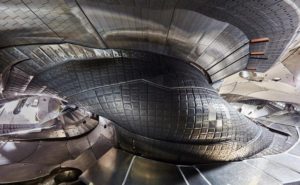 Wide angle view of the interior of the Wendelstein 7-X plasma vessel, showing the different armor materials designed to take up the heat from the plasma. The surface contour of the wall follows the shape of the plasma. On average, the radius of the plasma is 55 cm. Credit: Bernhard Ludewig, Max Planck Institute of Plasma Physics
Wide angle view of the interior of the Wendelstein 7-X plasma vessel, showing the different armor materials designed to take up the heat from the plasma. The surface contour of the wall follows the shape of the plasma. On average, the radius of the plasma is 55 cm. Credit: Bernhard Ludewig, Max Planck Institute of Plasma Physics
At the end of 2018, operation of the W7-X ceased and a new round of modifications was started. Key upgrades being implemented now for the W7-X are:
- Installation of new water-cooled inner cladding on large sections of the plasma vessel to enable the W7-X to handle higher heating loads and longer plasma pulses, up to 30 minutes.
- Installation of ten double strip, water-cooled divertor plates on the inner wall of the plasma vessel. Divertors are the parts of the new cladding system used to regulate the interaction between plasma and the inner wall of the plasma vessel. Without water cooling, the heat-resistant divertor tiles made of carbon-fiber-reinforced carbon could not withstand the heat load for the intended 30-minute plasma pulses.

In ten curved double strips, the divertor plates (brown) follow the shape of the twisted plasma (yellow). Source: IPP
IPP reports that this upgrade work is expected to continue until the end of 2021. You’ll find more details on the upgrade work, including the design of the divertors, on the IPP website at the following link: https://www.ipp.mpg.de/4828222/01_20
Conclusion
Following the success of two Wendelstein 7-X experimental campaigns from March 2016 to October 2018, a promising path forward is being pursued by the Max Planck Institute for Plasma Physics. Nonetheless, I believe my previous conclusion (below, from the original post in 2017) still stands. We’ll know a lot more after the W7-X upgrade work is completed and operations resume in late 2021.
So the jury is still out on the ability of advanced, optimized stellarators to take the lead over tokamaks in the long, hard journey toward the goal of delivering usable power from a fusion machine. Hopefully, the advanced stellarators will move the fusion community closer to that goal. No doubt, we still have a very long way to go before fusion power becomes a reality.
For more background information on stellarators:
A summary of Dr. Spitzer’s pioneering work at PPPL is documented in the following presentation:
- “Spitzer’s Pioneering Fusion Work and the Search for Improved Confinement,” which you can download at the following link: http://w3.pppl.gov/~hammett/refs/2013/Spitzer_100th_Hammett_2013.pdf
There are good briefings on the basics of stellarator design and operation in the following two documents:
- Dudson, B., “Stellarators,” University of York, UK, 6 February 2014 at the following link: http://www-users.york.ac.uk/~bd512/teaching/media/mcf_lecture_06.pdf
- Beidler, C.D., et al., “Stellarator Fusion Reactors – an Overview”, Max-Planck Institute for Plasma Physics, 2001, at the following link: http://fire.pppl.gov/itc12_wobig_paper.pdf
